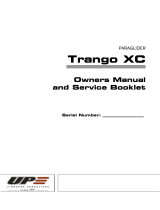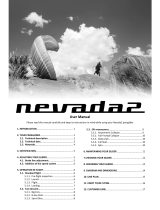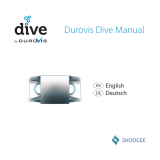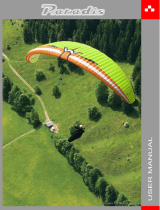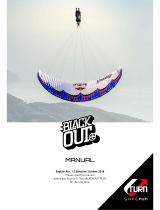Page is loading ...

Thank you for choosing to y an Ozone Ultralite.
It is essential that you read this manual before ying your Ultralite.
Ozone’s web site, www.yozone.com or www.yozone.com//pgframe.asp?pge=gliders-
Ultralite.htm carries up-to-date information, including any safety issues or issues
specic to your Ultralite. Please check it regularly.
Safe Flying
All the team @ Ozone
3
ENGLISH

WARNING
Paragliding is a potentially dangerous sport that can cause serious injury including
bodily harm, paralysis and death.
Flying an Ozone paraglider is undertaken with the full knowledge that paragliding
involves risks.
As the owner of an Ozone paraglider you take exclusive responsibility for all risks
associated with its use. Inappropriate use and or abuse of your equipment will
increase these risks.
Ozone paragliders are only suitable for qualied pilots or those under instruction.
Any liability claims resulting from use of this product towards the manufacturer,
distributor or dealers is excluded.
Make sure you complete a thorough daily and pre-ight inspection of all of your
equipment. Never attempt ying with unsuitable or damaged equipment.
Always wear a helmet, gloves and boots, and always y with a reserve
parachute.
YOUR ULTRALITE
The Ultralite is the lightest wing Ozone has ever made, it is the perfect mountain
descent wing, making the climb a pleasure and also giving enough performance to
thermal, ridge soar and even take you XC. It has been developed from the Element, a
safe, stable planform that has impeccable launching characteristics and added in-
ight comfort
Our aim whilst designing the Ultralite was to produce the lightest available wing on the
market whilst retaining Ozone’s trademark handling and, safety. It has been certied at
DHV 1-2 and complies with the new CEN tests, so is suitable for a wide range of pilots.
If you are a keen mountaineer or hill climber and require the lightest possible glider,
then the Ultralite is for you.
Weight saving has been uncompromised; a simple, uncluttered wing design made
from 27gr Porcher Marine Skytex throughout except at critical, structural areas such
as the leading edge and cell walls where the heavier, but more durable 36g Skytex has
been used. You will notice the risers are completely different and the maillons have
been removed with the lines linked directly to the risers for added weight saving. The
new risers are made from strong, warp resistant Dyneema which are both long lasting
and light
All of this innovation makes the Ultralite 23 weigh in at a mere 2.85kgs!
Please note.The light weight materials will last very well, however they will not accept
the same level of abuse as a glider made from heavier cloth. Groundhandle to a
minimum and always ensure your glider is dry before packing.
Brake Lines
The brake line lengths have been set carefully during testing. We feel it is better to
have slightly long brake lines and to y with a wrap (one turn of line around the hand).
However, if you do choose to adjust them, do so in a progressive manner to ensure
that they are not over-shortened.
IMPORTANT : In the unlikely event of a brake line snapping in ight, or a
handle becoming detached, the glider can be own by gently pulling the rear
risers (C-risers) for directional control.
Risers
To make the glider even lighter, we have designed the ULTRALITE with lightweight
Dyneema risers. The risers are independantly detachable in order to change damaged
lines.
The A risers have a red coloured tab to make them easier to identify.
Accelerator System
Ensure the speed system is connected properly.
To use the speed system, ensure your hands are high (so that no brake is applied) and
then extend the speed bar loop smoothly with your feet. Full speed is achieved when
the pulleys on the risers are touching. Once set up test the full range of the accelerator
in calm ying conditions; ensure that both risers are pulled evenly during operation.
Fine-tuning can be completed when you are back on the ground.
IMPORTANT : Using the accelerator decreases the angle of attack and can
make the glider more likely to collapse, therefore using the accelerator near
the ground should be avoided.
We would advise you not to use the accelerator when ying in turbulence.
Snow Tabs
The Ultralite comes supplied with snow tabs to assist with launching on steep snow
slopes. The tabs can be attached using a simple larks foot on the available loops
located on the top surface. The tabs should be removed when not necessary, to avoid
any wear or vibration in ight.
Harness
The chest strap should be set at 44, 46(between the centres of the risers) for sizes 23
and 25 respectively.
Total weight in ight
Each Ultralite has been certied for a dened weight range. We recommend that you
respect these weight ranges.
4

Preparation
Lay out the ULTRALITE on its top surface in a pronounced arc, with the centre of the
wing higher than the tips. Lay out the lines one side at a time. Hold up the risers and
starting with the brake lines, pull all lines clear. Repeat with the C, B and A lines, laying
the checked lines on top of the previous set, and making sure no lines are tangled,
knotted or snagged. Mirror the process on the other side.
Launching
Your ULTRALITE will launch with either the forward or reverse techniques.
Whilst inating your wing, you should hold the A risers on each side. Once clipped in,
and you have gone through the take-off check list (above), stand central to the wing to
ensure an even and progressive ination.
Forward Launch - Nil to Light winds
When the wind is right, move forward, your lines should become tight within one
or two steps. The ULTRALITE will immediately start to inate. Due to the extreme
lightweight nature of the glider it is not necessary to use force on the A risers to initiate
the ination. Only once the glider is fully inated with air should you put pressure on
the A risers to aid the complete ination overhead.
Do not pull down or push the risers forward excessively, or the leading edge will
deform and make taking-off difcult.
Move smoothly throughout the entire launch, there is no need to rush or snatch at it.
You should have plenty of time to look up and check your canopy before committing
yourself.
Once you are happy that the ULTRALITE is inated correctly, accelerate smoothly off
the launch.
Reverse Launch -Light to Strong Winds
Lay out your ULTRALITE as you would for the forward launch. However, this time turn
to face the wing, passing one entire set of risers over your head as you turn. To inate
the Ultralite hold the A-risers, but mainly use your weight and tension in the lines to
bring the glider up. Only use gentle force on the A risers if necessary to bring the glider
fully overhead. Once the wing is overhead, brake gently to stop any overshoot, turn
and smoothly accelerate in order to launch.
In stronger winds, be prepared to take a few steps towards the glider as it inates. This
will take some of the energy out of the glider and it will be less likely to over y you.
IMPORTANT: Never take off with a glider that is not fully inated or if you
are not in control of the pitch/roll of your wing.
IN FLIGHT CHARACTERISTICS
The Ultralite shows no unusual ying characteristics, consequently it is suitable for a
very wide range of pilot. However due to the lightweight nature and small surface area
of the wing, turns are very direct and precise , requiring smooth inputs. In turns, the
ULTRALITE is smooth and co-ordinated, on glides it remains solid and well pressured,
even through the accelerated speed range. It has a very high resistance to both
collapses and stalls. However, to get the most out of your ULTRALITE we advise you
to consider the following information.
Normal Flight
Flying at ‘trim speed’ (hands-up), your glider will achieve its ‘best glide’ speed. Apply
the brakes approximately 30cm to reach the minimum-sink rate. To increase your
speed for headwind glides, use the accelerator bar which will give you an increase in
speed of up to 10km/h.
Turning
To familiarise yourself with the ULTRALITE your rst turns should be gradual and
progressive.
To make efcient and co-ordinated turns with the ULTRALITE rst check that the
airspace is clear. Initiate the turn using weight-shift followed by a smooth application
of the brake until the desired bank angle is achieved. To regulate the speed and radius
of the turn, use the outer brake.
IMPORTANT: never initiate a turn at minimum speed (i.e. with full brakes
on) as you could risk entering a spin.
REMEMBER: This is a small glider with a high wing loading, turns are
consequently more dynamic and immediate relative to a larger model. Turns
should be initiated smoothly and progressively, epecially when own close to
a hill.
Landing
The Ultralite shows no unusual landing characteristics but as a reminder, here are
some tips:
• Allow the glider to y at glide at full speed for your nal descent until you are around
1 metre above the ground. Apply the brakes slowly and progressively to slow the glider
down until the glider stalls and you are able to step on to the ground.
• Be careful not to are too hard at full speed as the glider might climb again before
stalling. If the glider does begin to climb, ease off the brakes until it stops climbing,
then are again, but slower this time. If this does happen, don’t put your hands up! You
should keep the brakes at mid speed, stand up, be ready to run and make sure you
brake fully as you arrive on the ground.
5
ENGLISH

• Always land heading into wind!
• In light winds you need a strong, long and progressive are to bleed off all your
excess ground speed. In strong winds your forward speed is already low so you are
aring to soften the impact as you touch down.
• If the wind is very strong, and you feel you might be dragged, stall the glider with the
C risers. This stalls the Ultralite in a very quick and controllable way and will drag you
less then if you use the brakes.
Packing
• Spread the glider at on its top surface, then lay the lines on top. The risers should
be laid on the ground, at the centre of glider, near the trailing edge.
• Take a wing tip and fold it in to the centre of the wing. Repeat this until the glider is
folded up and approx. 60 cm’s wide.
• Push out any remaining air by attening the folded wing from the trailing edge to the
leading edge.
• Fold the glider so that the bundle is approximately the size and shape of the OZONE
rucksack. Never roll the wing up as this introduces unnecessary stresses into the
fabric.
• Always pack your Ultralite as loosely as you can, as every fold weakens the cloth on
any paraglider.
• Finally, wrap the glider tie around the bundle and put it in the stuff sack.
• Packing your glider using the concertina method, keeping the mylar stiffners at may
prolong the life your glider.
RAPID DESCENT TECHNIQUES
Ozone would like to remind you that these manoeuvres should be learnt under the
supervision of a qualied instructor and always used with caution. Never forget that
properly analysing the conditions before launch will help avoid the need to use these
techniques.
Big Ears
Folding in the wingtips of the ULTRALITE increases its sink rate. To pull big ears on the
ULTRALITE, keep holding your brake handles and take the outermost A-line on each
side, then pull it down until the tips of the wing fold under.
Do not use the brakes other than for re-ination. For directional control while using the
Big Ears, you should use weight shift steering.
To reopen your ears, release the outside A line: the glider should reopen automatically.
You can still help the reination by braking gently, one side at a time to minimise the
chance of inducing a stall.
IMPORTANT: You can land with the ears (you should release the ears before
nal are). But Ozone don’t advise you to do this when it’s turbulent or windy
due to the risk of a possible stall and lack of precision in steering.
Big ears and accelerator
Once the big ears are in you can further increase the sink rate by pushing on the
accelerator bar.
NEVER try to pull the Big Ears in with the speed bar on. This can lead to a major
asymmetric deation.
Big ears and spiral dive
Whilst it is possible to enter a spiral dive whilst holding in Big Ears, the high forces
applied to the lower lines could exceed the breaking strain of the lines leading to
equipment failure!
Ozone do not recommend the use of this manoeuvre!
B-Line Stall
B-stall is for fast descents in emergency situations only. B-stall is performed by
symmetrically pulling down on the B-risers.
To initiate the B-stall place your ngers between the lines on the B risers. Do not
release the brake handles. As you pull the B-lines down the airow over the wing is
broken and the glider loses its forward speed but remains open and you will descend
at around 6 m/s.
To exit the B-stall the B-risers should be released symmetrically and in one smooth,
progressive motion. The glider will resume normal forward ight without further input.
Check you have forward ight again before using the brakes.
IMPORTANT: The pitching movement on exiting the B stall is small but
necessary. We recommend you do not brake the glider until you are sure that
the glider is ying again.
The load applied on the B lines during this manoeuvre is not very good for your
glider, only use it in emergency situations.
Spiral Dives
If you turn your Ultralite in a series of tightening 360’s it will enter a spiral dive. This will
result in rapid height loss. To initiate a spiral, look and lean in to the direction you want
to go, then smoothly pull down on the inside brake. The Ultralite will rst turn almost
360 degrees before it drops in to the spiral. Once in the spiral you must apply a little
outside brake to keep the outer wing tip pressured and inated.
Safe descent rates of 8 metres per second (500 ft/min approx.) are possible in a spiral
dive, but at these rates the associated high speeds and G-forces can be disorientating,
so pay particular attention to your altitude.
To exit the spiral dive, return your weight shift to a central position and then slowly
release the inside brake. The Ultralite shows no indication of remaining neutral in the
spiral dive, however if it does so,you should always be prepared to pilot the wing out.
6

To do so smoothly use opposite weight shift and apply a small amount of outside
brake and the glider will start to resume normal ight. Never attempt to recover from a
spiral with hard or quick opposite inputs as this will result in an aggressive climb and
surge.
IMPORTANT: Spiral dives with sink rates over 8 m/s are possible, but should
be avoided. They are dangerous and put unnecessary strain on the glider.
Spiral dives cause disorientation and need time and height to recover. Do not
perform this manoeuvre near the ground.
INCIDENTS
Deep Stall / Parachutal stall
It is possible for gliders to resume their normal shape on a very slow release of the B-
lines, but carry on descending vertically and without full forward motion. This situation
is called ‘deep stall’ or ‘parachutal stall’.
It is highly unlikely to happen on any OZONE glider, but should it happen, your rst
reaction should be to fully raise both brakes and the glider should return to normal
ight. If nothing happens after a few seconds, reach up and push the A-risers forwards
or apply the speeds bar to regain normal ight.
Ensure the glider has returned to normal ight (check your airspeed) before you use
the brakes again.
IMPORTANT: only a few cms of input from your brakes can maintain your
wing in the stall. Always release your wraps if you have taken them!
Deations
If you have a collapse, the rst thing to do is to control your direction: You should y
away from the ground or obstacles and other pilots, or at least not to y into them...
Asymmetrical collapses can be controlled by weight shifting away from the collapse
and applying a small amount of brake to control your direction. This act will most of
the time be enough for a full recovery of the wing.
Once a glider is deated it is effectively a smaller wing, so the wing loading and stall
speed are higher. This means the glider will spin or stall with less brake input than
normal. In your efforts to stop the glider turning towards the collapsed side of the wing
you must be very careful not to stall the side of the wing that is still ying. If you are
unable to stop the glider turning without exceeding the stall point then allow the glider
to turn whilst you reinate the collapse.
If you do have a deation which does not spontaneously reinate, make a long smooth
progressive pump on the deated side. This pumping action should take about 2
seconds per pump. Pumping too short and fast will not reinate the wing and pumping
too slow might take the glider too close, or beyond, the stall point.
Symmetrical collapses reinate without pilot input, however 15 to 20cm of brake
applied symmetrically will speed the process.
If your Ultralite collapses in accelerated ight, immediately release the accelerator to
slow down to trim speed and after a 90 deg turn the canopy will reinate and return to
normal ight.
IMPORTANT: No pilot and no glider are immune to collapses however active
ying will virtually eliminate any tendency to collapse. When the conditions are
turbulent, be more active and anticipate the movements of your wing. Always
be aware of your altitude and do not over-react. We advice you to keep hold of
your brakes. Do not y in turbulent conditions.
Cravats
When the tip of your wing gets stuck in the lines, this is called a ‘cravat’. This can
make your glider go into a rotation which is difcult to control. The rst solution to
get out of this situation is to pull down the stabilo line (red line on the B riser), while
controlling your direction, you must be careful with any brake inputs not to stall the
opposite wing.
If this doesn’t work, a full stall is the only other option. This shouldn’t be done unless
you have been taught how to do it and can only be done with a large amount of
altitude. Remember if the rotation is accelerating and you are unable to control it, you
should use your reserve whilst you still have enough altitude.
IMPORTANT: A bad preparation on launch, aerobatic ying, ying a wing of
too high a level or in conditions too strong for your ability, are the main causes
of cravats.
ACROBATICFLYING
Towing
The ULTRALITE may be tow-launched. It is the pilot’s responsibility to use suitable
harness attachments and release mechanisms and to ensure that they are correctly
trained on the equipment and system employed. All tow pilots should be qualied to
tow, use a qualied tow operator with proper, certied equipment, and make sure all
towing regulations are observed.
MATERIALS
All OZONE gliders are made from the highest quality materials available. Your Ozone
ULTRALITE is constructed from:
Upper-surface
Hybrid
7
ENGLISH

Porcher Marine Skytex 27 Classic
Porcher Marine Skytex 36g Classic (Leading edge)
Lower-surface
Porcher-Marine Skytex 27g Classic
Internal Ribs
Porcher-Marine Skytex 40g hard and 27 Classic
Leading-edge reinforcement
Double-laminated Mylar.
Lines
Lower cascades - Edelrid Aramid, 8000 series - 230 kg’s breaking strength - 1.8 mm
Middle cascades - Edelrid Aramid, 8000 series – 190kg’s breaking strength - 1.1 mm
Upper cascades - Liros DC - 60 kg’s breaking strength - 0.95 mm
Risers and hardware
Riser webbing – Amsteel Dyneema 7mm
Pulleys – Ronstan Lightweight plastic
All these components have been selected for their renowned quality, weight saving
and durability.
MAINTENANCE
Storage
Always store all your ying equipment in a dry room, protected from direct heat.
Your wing should be dry before being packed away. Heat and humidity are the worst
factors in damaging your glider. (Storing a damp glider in your car under the sun would
be terrible for example).
Dry your wing preferably out of the sun, in the wind. Never use a hair dryer, etc.
If you land in the salt water, you must clean it with fresh water rst and then dry it.
Take care that no insects get packed away with the wing they may eat the cloth and
make some holes in a bid to escape, they can also leave acidic deposits if they die
and decompose.
Cleaning
Any kind of wiping/scratching can damage the coating of the cloth. We recommend for
cleaning your ULTRALITE, you use a soft cloth dampened only with water and to use
gentle movements little by little across the surface.
Never use any detergent or chemical cleaners
Wing Repairs
If the rip is small, you can x it yourself. You’ll nd all the materials in the repair kit you
need.
The Porcher Marine fabric can be simply mended with the sticky rip stop / spinnaker
tape.
You can nd more information about repairing your wing on the Ozone website,
including step by step instructions with pictures.
Damaged line
Any line that is damaged should be replaced by a qualied professional. It is important
that the replacement line is made from the same material, has the same strength and
the same length. Once the line has been replaced, inate and check the glider before
ying. If you do not have access to an Ozone dealer you can order individual lines at
www.yozone.com(or www.aerorosport.de if you are from Germany or Austria).
Maintenance checks
Your wing should be checked by a qualied professional for the rst time after 12
months, and thereafter every 12 months. If used heavily we recommend checks every
80 hours.
We recommend that the check up is carried out by a qualied professional.
You are responsible for your ying kit and your safety depends on it. Take care of it and
have regularly a inspect all of its components. Changes in a wings ying behaviour,
are also indicators of the gliders aging, if you notice any changes you should have the
wing checked before ying again.
These are the basic elements of the check up (full details and permissable gures can
be found on our website).
Modications
Your Ozone Ultralite was designed and trimmed to give the optimum balance of
performance, handling and safety. Any modication means the glider loses its
certication and will also probably be more difcult to y. For these reasons, we
strongly recommend that you do not modify your Ultralite in any way.
8

9
ENGLISH
QUALITY
At Ozone we take the quality of our products very seriously, all our gliders are made
to the highest standards in our own manufacturing facility. Every glider manufactured
goes through a stringent series of quality control procedures and all the components
used to build your glider are traceable. We always welcome customer feedback and
are committed to customer service. We will always undertake to x problems not
caused by general wear and tear or inappropriate use. If you have a problem with your
glider please contact your dealer/distributor who will be able to decide upon the most
appropriate action. If you are unable to contact your dealer then you can contact us
directly at info@yozone.com

10
MANUELDEVOL
page 10 > 17
Line diagram > page 28 - Riser diagram > page 30
Technical specications > page 31

18
BETRIEBSHANDBUCH
page 18 > 27
Line diagram > page 28 - Riser diagram > page 30
Technical specications > page 31

31
No. of Cells
Projected Area (m2)
Flat Area (m2)
Projected Span (m)
Flat Span (m)
Projected Aspect Ratio
Flat Aspect Ratio
Root Chord
Glider Weight
In-Flight Weight Range
DHV
23
35
20.16
22.89
8.37
10.2
3.47
4.54
2.79
2.85
55-90
1-2
25
35
22
25
8.74
10.66
3.47
4.54
2.91
3.1
65-105
1-2
TECHNICAL SPECIFICATIONS
/
